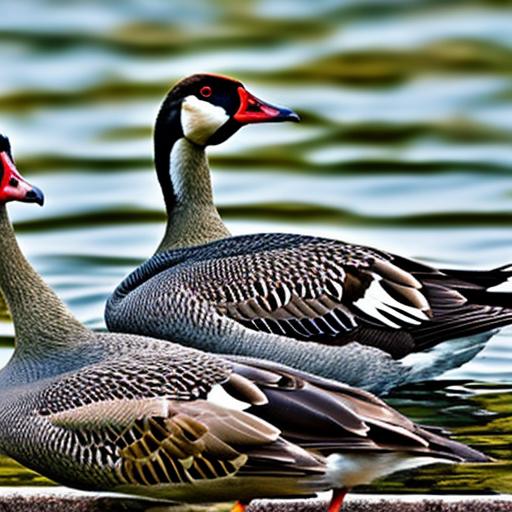Canadian geese are a common sight on docks and waterfront properties across Canada. While they may be beautiful to look at, their presence can cause a number of problems. From leaving behind droppings that can be unsightly and unsanitary to damaging property with their nesting habits, finding humane solutions to manage geese on docks is essential. In this article, we will explore various methods that can be used to deter geese from landing on docks and waterfront properties, ensuring a clean and safe environment for both humans and geese.
Key Takeaways
- Canadian geese are attracted to open water and grassy areas near water sources
- Visual deterrents such as scarecrows and reflective tape can help keep geese away from your dock
- Physical barriers like netting or fencing can prevent geese from landing on your dock
- Sound deterrents like loud noises or predator calls can also be effective in deterring geese
- Keeping your dock area clean and free of food sources can discourage geese from sticking around
Understanding the behavior of Canadian geese
To effectively deter geese from landing on docks, it is important to understand their behavior. Canadian geese are migratory birds that travel long distances during their annual migrations. They typically nest in areas near water, making docks and waterfront properties an attractive location for them. Geese are also social animals and tend to gather in large groups, which can further attract them to areas where other geese are present.
Implementing visual deterrents on your dock
Visual deterrents can be an effective way to discourage geese from landing on docks. Scarecrows and reflective tape are two commonly used visual deterrents. Scarecrows can be placed strategically around the dock area to create the illusion of a human presence, which can scare away geese. Reflective tape can be hung from poles or other structures near the dock, creating flashes of light that can startle geese and make them think twice about landing.
To use visual deterrents effectively, it is important to regularly move them around the dock area. Geese can become accustomed to stationary scarecrows or reflective tape, so changing their location periodically can help maintain their effectiveness. Additionally, it is important to ensure that visual deterrents are properly maintained and in good condition. Broken or faded scarecrows or reflective tape may not be as effective in deterring geese.
Installing physical barriers to prevent geese from landing
Physical barriers can be another effective method for preventing geese from landing on docks. Netting and fencing are two commonly used physical barriers. Netting can be installed around the perimeter of the dock, creating a barrier that prevents geese from accessing the area. Fencing can also be used to create a physical barrier, but it is important to ensure that the fence is tall enough to prevent geese from flying over it.
When installing physical barriers, it is important to consider the height and strength of the barrier. Geese are strong birds and can easily knock down or fly over weak or low barriers. Additionally, it is important to regularly inspect and maintain physical barriers to ensure they remain effective. Any damage or wear should be repaired promptly to prevent geese from finding a way through.
Utilizing sound deterrents to keep geese away
Sound deterrents can be an effective method for keeping geese away from docks. Noise makers and predator calls are two commonly used sound deterrents. Noise makers, such as air horns or whistles, can be used to create loud and sudden noises that startle geese and make them uncomfortable. Predator calls, such as recordings of natural predators like hawks or owls, can also be effective in deterring geese.
To use sound deterrents effectively, it is important to vary the sounds and patterns. Geese can become accustomed to repetitive or constant noises, so changing the type and timing of the sounds can help maintain their effectiveness. It is also important to consider the volume of the sound deterrents. While loud noises can be effective in scaring away geese, they should not be so loud as to disturb nearby residents or wildlife.
Maintaining a clean dock area to discourage geese

Keeping the dock area clean and free of food scraps and debris is an important step in discouraging geese from landing. Geese are attracted to areas where they can find food, so removing any potential food sources can help deter them. Regularly sweep or hose down the dock to remove any food scraps or debris that may have accumulated. Additionally, it is important to properly dispose of any garbage or food waste in sealed containers to prevent geese from accessing it.
Maintaining a clean dock area also includes regularly removing any droppings left behind by geese. Geese are creatures of habit and will return to areas where they have previously found food or nesting spots. By regularly cleaning up droppings, you can help break this cycle and discourage geese from returning to your dock.
Using motion-activated devices to scare off geese
Motion-activated devices can be an effective way to scare off geese from docks. Sprinklers and lights are two commonly used motion-activated devices. Sprinklers can be set up around the dock area and programmed to turn on when motion is detected, creating a sudden burst of water that startles geese and makes them uncomfortable. Lights can also be used in a similar manner, turning on when motion is detected and creating a sudden burst of light that scares away geese.
To use motion-activated devices effectively, it is important to strategically place them around the dock area. Geese are intelligent birds and can quickly learn to avoid areas where they have encountered motion-activated devices in the past. By regularly moving the devices around and changing their location, you can help maintain their effectiveness.
Planting vegetation that geese dislike near your dock
Planting vegetation that geese dislike near your dock can be an effective long-term solution for deterring geese. Tall grasses and shrubs are two types of vegetation that geese tend to avoid. By planting these types of vegetation near your dock, you can create a natural barrier that geese are less likely to land on.
When planting vegetation, it is important to consider the location and maintenance requirements of the plants. Choose plants that are suitable for your climate and that will thrive in the conditions near your dock. Additionally, it is important to regularly maintain the vegetation by trimming and pruning as needed. Overgrown or neglected vegetation may not be as effective in deterring geese.
Seeking professional help for geese control on your property
If other methods are not effective in managing geese on your dock, it may be necessary to seek professional help. Geese control professionals have the knowledge and experience to effectively manage geese populations and can provide guidance on the best methods for your specific situation. When seeking professional help, it is important to do your research and find a reputable geese control professional. Ask for recommendations from friends or neighbors, and check online reviews or testimonials before making a decision.
Creating a designated feeding area away from your dock
Creating a designated feeding area away from your dock can help discourage geese from landing. By providing an alternative location for geese to feed, you can redirect their attention away from your dock. Choose an area away from the dock and regularly scatter birdseed or other food sources for the geese to find.
When creating a designated feeding area, it is important to regularly monitor and maintain it. Ensure that the area remains clean and free of debris, and regularly replenish the food sources to keep geese coming back to that location instead of your dock.
Educating yourself on local regulations regarding geese management
Understanding local regulations regarding geese management is important when implementing deterrent methods on your dock. Different regions may have specific rules or guidelines regarding the use of certain deterrents or the management of geese populations. Educate yourself on these regulations to ensure that you are in compliance and not inadvertently causing harm to wildlife or violating any laws.
To educate yourself on local regulations, contact your local wildlife or environmental agency. They can provide you with information on any specific regulations or guidelines that apply to your area. Additionally, they may be able to provide guidance on the most effective and humane methods for managing geese on your dock.
In conclusion, finding humane solutions for geese management on docks and waterfront properties is essential. By understanding the behavior of Canadian geese and implementing various deterrent methods, such as visual deterrents, physical barriers, sound deterrents, maintaining a clean dock area, using motion-activated devices, planting vegetation that geese dislike, creating a designated feeding area, seeking professional help, and educating yourself on local regulations, you can effectively deter geese from landing on your dock. Take action today to implement these tips and create a clean and safe environment for both humans and geese.
If you’re looking for ways to keep Canadian geese off your dock, you might also be interested in learning how to create a safe and comfortable environment for your chickens. Poultry Wizard offers a helpful article on “Turning a Shed into a Chicken Coop,” which provides valuable insights and tips on transforming an existing structure into a suitable home for your feathered friends. By implementing some of the strategies mentioned in this article, such as securing the coop and creating a predator-proof environment, you can not only protect your chickens but also potentially deter unwanted visitors like Canadian geese. Check out the article here for more information.
Meet Walter, the feathered-friend fanatic of Florida! Nestled in the sunshine state, Walter struts through life with his feathered companions, clucking his way to happiness. With a coop that’s fancier than a five-star hotel, he’s the Don Juan of the chicken world. When he’s not teaching his hens to do the cha-cha, you’ll find him in a heated debate with his prized rooster, Sir Clucks-a-Lot. Walter’s poultry passion is no yolk; he’s the sunny-side-up guy you never knew you needed in your flock of friends!







